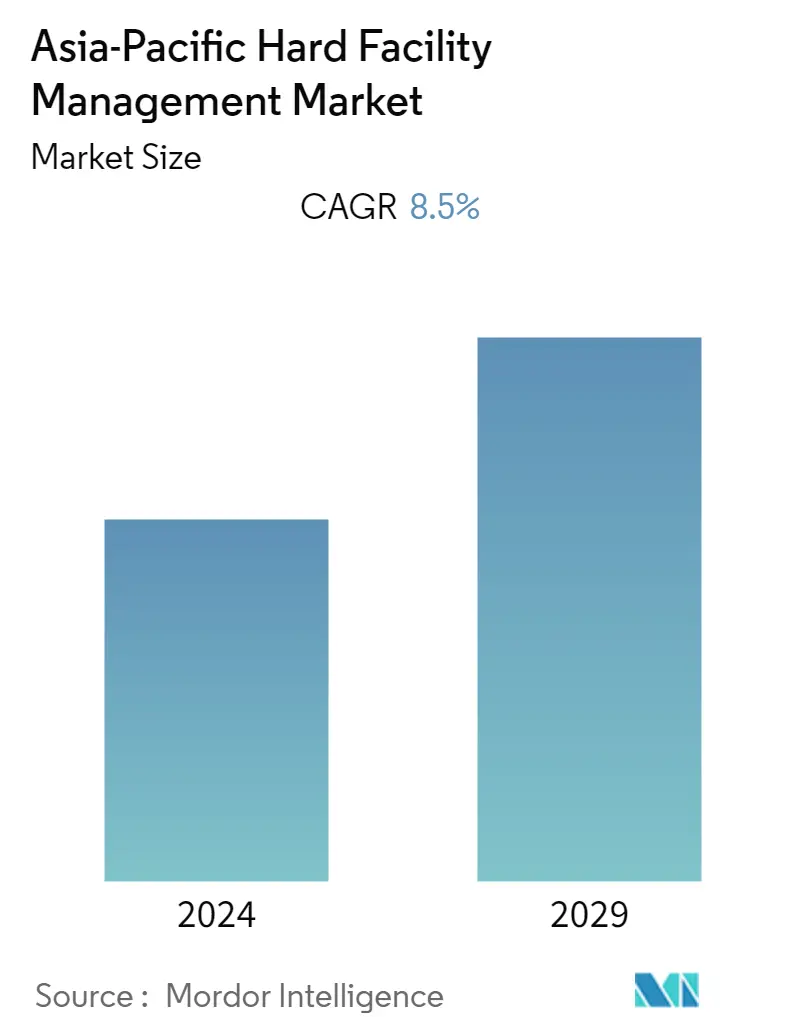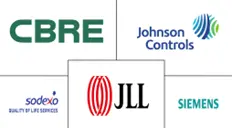Market Size of Asia-Pacific Hard Facility Management Industry

| Study Period | 2019 - 2029 |
| Base Year For Estimation | 2023 |
| Forecast Data Period | 2024 - 2029 |
| Historical Data Period | 2019 - 2022 |
| CAGR | 8.50 % |
| Market Concentration | Low |
Major Players
*Disclaimer: Major Players sorted in no particular order |
APAC Hard Facility Management Market Analysis
The Asia-Pacific hard facility management (HFM) market revenue is expected to record a CAGR of 8.5% over the next five years. The market is anticipated to continue growing due to the increased urbanization and population in the region.
- To find ways to combat air pollution in Asia-Pacific, the Economic and Social Commission for Asia and the Pacific (ESCAP) of the United Nations hosted several knowledge-sharing workshops. These discussions centered on enhancing regional collaboration and facilitated a wider interchange of creative approaches to reducing air pollution and best practices, including necessary regulations, data, and technology. HVAC systems are crucial to maintaining high interior air quality with sufficient ventilation and filtration. HVAC cleaning services are necessary to clean and maintain the ventilation ducts, filters, chimneys, and other system components from dust, debris, and germs.
- The increased potential expansion of retail, commercial, and residential is expected to propel the Asia-Pacific facility management industry in the next six years. The region is primarily driven by an increase in industrial and building activity, particularly in the commercial sector, which is backed by several government programs like the "Smart City Mission of India." The growing several commercial buildings in India, China, and Singapore are giving rise to the demand for hard facility services from construction design and fire equipment to escalator maintenance.
- Since the pandemic's start, macroeconomic and geopolitical headwinds have put pressure on distribution networks and exposed weaknesses in supply chains throughout the Asia-Pacific, with the region's heavy equipment and HVAC facility maintenance services being among those most impacted. Because construction supplies are more difficult to get and need longer lead times, these supply chain bottlenecks are considerably lengthening the schedules for commercial build-out and occupant improvement projects throughout the area.
- Furthermore, growth in tourists, particularly from Southeast Asian nations like Thailand, Indonesia, the Philippines, Malaysia, India, and Maldives, is supporting the growing hospitality sector. The growing demand for tourist accommodations has created opportunities for hiring a facility management team, which is held accountable for managing hotel properties and tourist amenities. This prominent role played by facility management is anticipated to positively affect the growth of the Asia-Pacific facility management market over the forecast period.
- After the epidemic, regulations still encourage proper cleanliness practices. Included in these procedures are the placement of hand sanitizers in all public places, an increase in office ventilation, and air purification. Other safety precautions include face mask zones, a one-way system, and social seclusion by designed light weigh cubicles. It would be incumbent on facility managers to maintain these standards going ahead and to make sure that all precautions are taken.
APAC Hard Facility Management Industry Segmentation
Hard Facility Management (HFM) services manage the technology, systems, and equipment that make up a company's physical structure.
The Asia-Pacific HFM market is segmented by type (mechanical, electrical, plumbing (MEP) and HVAC maintenance services, enterprise asset management, and other HFM services), end user (commercial, institutional, public/infrastructure, industrial, and other end users), and geography. The market sizes and forecasts are provided in terms of value (USD million) for all the above segments.
| By Type | |
| MEP (Mechanical, Electrical, Plumbing), and HVAC Maintenance services | |
| Enterprise Asset Management | |
| Other Hard FM Services |
| By End User | |
| Commercial | |
| Institutional | |
| Public/Infrastructure | |
| Industrial | |
| Other End Users |
| By Geography | |
| Australia | |
| China | |
| India | |
| Japan | |
| Indonesia | |
| Malaysia | |
| Singapore | |
| South Korea | |
| Taiwan | |
| Thailand | |
| Rest of Asia-Pacific |
Asia-Pacific Hard Facility Management Market Size Summary
The Asia-Pacific Hard Facility Management (HFM) market is experiencing significant growth, driven by increased urbanization and industrial activity in the region. The market is expanding rapidly due to the rise in commercial, retail, and residential developments, particularly in countries like India, China, and Singapore. Government initiatives such as India's Smart City Mission are further propelling the demand for HFM services, which include essential maintenance and management of facilities to ensure safety and efficiency. The hospitality sector is also contributing to market growth, with a surge in tourist accommodations necessitating robust facility management to maintain high standards of service and safety. Despite challenges posed by supply chain disruptions and geopolitical tensions, the market is poised for continued expansion as infrastructure and construction activities ramp up across the region.
The HFM industry in Asia-Pacific is characterized by a fragmented landscape with both local and international players offering a range of services. Major companies like Sodexo, Inc., Jones Lang LaSalle Incorporated (JLL), CBRE Group Inc, Johnson Controls International, and Siemens AG are actively enhancing their service portfolios through technological integration and strategic partnerships. These firms are focusing on sustainability and energy efficiency, aligning with global trends towards reducing carbon footprints. The post-pandemic emphasis on cleanliness and safety standards, particularly in HVAC systems maintenance, is also shaping the market dynamics. As the region recovers and grows, the HFM sector is expected to play a crucial role in supporting the infrastructure and commercial real estate developments, ensuring they meet modern standards of safety, efficiency, and sustainability.
Asia-Pacific Hard Facility Management Market Size - Table of Contents
-
1. MARKET INSIGHTS
-
1.1 Market Overview
-
1.2 Industry Attractiveness-Porter's Five Force Analysis
-
1.2.1 Bargaining Power of Suppliers
-
1.2.2 Bargaining Power of Consumers
-
1.2.3 Threat of New Entrants
-
1.2.4 Threat of Substitute Products
-
1.2.5 Intensity of Competitive Rivalry
-
-
1.3 Impact of COVID-19 on the Hard Facility Management Industry
-
-
2. MARKET SEGMENTATION
-
2.1 By Type
-
2.1.1 MEP (Mechanical, Electrical, Plumbing), and HVAC Maintenance services
-
2.1.2 Enterprise Asset Management
-
2.1.3 Other Hard FM Services
-
-
2.2 By End User
-
2.2.1 Commercial
-
2.2.2 Institutional
-
2.2.3 Public/Infrastructure
-
2.2.4 Industrial
-
2.2.5 Other End Users
-
-
2.3 By Geography
-
2.3.1 Australia
-
2.3.2 China
-
2.3.3 India
-
2.3.4 Japan
-
2.3.5 Indonesia
-
2.3.6 Malaysia
-
2.3.7 Singapore
-
2.3.8 South Korea
-
2.3.9 Taiwan
-
2.3.10 Thailand
-
2.3.11 Rest of Asia-Pacific
-
-
Asia-Pacific Hard Facility Management Market Size FAQs
What is the current Asia-Pacific Hard Facility Management Market size?
The Asia-Pacific Hard Facility Management Market is projected to register a CAGR of 8.5% during the forecast period (2024-2029)
Who are the key players in Asia-Pacific Hard Facility Management Market?
Jones Lang LaSalle Incorporated (JLL), Sodexo S.A., CBRE Group Inc, Johnson Controls International and Siemens AG are the major companies operating in the Asia-Pacific Hard Facility Management Market.

